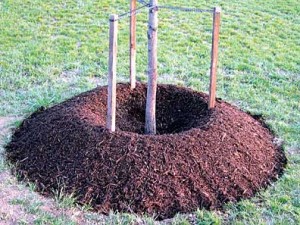
Digging too deep a hole can lead to problems, and it’s unnecessary work. Measure the height of the root ball or pot from the ground to the root flare (or top of the pot soil). That’s how deep your hole should be.
Plants breathe through their roots, so it’s very important to not cover the original pot soil or the top of the root ball. The area where the trunk meets the soil is called the “root collar” or “root flare”, and covering this with dirt or mulch causes problems. A common cause of tree death is planting trees too deep or covering the roots with soil so they can’t breathe. Some people do this to keep the tree from blowing over. A better way to keep trees straight is proper staking (see illustration). Heaping mulch around the tree trunk can cause the bark to rot and attract harmful insects; you should always be able to see the root flare.

Adding tree fertilizer to the soil when planting is magic. Fertilizer should be mixed with the planting soil so the roots will find it gradually as they grow. An easy way to do this is simply spread fertilizer and peat moss on the ground before you dig. As you dig it will be thoroughly mixed, and the peat moss makes digging much easier. If you hit gummy clay, discard it.
Not just any fertilizer will do. Dousing newly-planted trees with Miracle-Gro will burn the roots. Agricultural fertilizer like 10-10-10 is much too high in nitrogen and will cause suckering. We use Espoma Tree Tone, which has slow-release nitrogen and trace minerals. It also contains soil microbes (micorrizae), which restore tired soils and aid in digesting plant food. This helps the tree build a strong root system and trunk before it grows more branches, making it more likely to survive stress.
Fill in around the tree a few inches at a time, tamping carefully to prevent settling or air pockets that will dry out the tree. Make a small dike around the tree to hold water long enough to soak in around the roots, so in case there’s dry weather you can add five or ten gallons once a week.
The most common cause of death for newly planted trees is over-watering. Daily watering of trees does more harm than good. Trees prefer to dry out somewhat between waterings. Our soil here in Adams County tends to be heavy clay, so the planting hole often collects water and drowns the tree. Weekly deep root soaking is much better than watering every day. Keep a schedule of weekly watering regardless of rain. Rainfall won’t provide a deep-root soaking for newly planted trees.
Making a big mulch circle around the tree keeps grass from competing with the tree for water and food. It also prevents damage from lawn mowing, a cause of many tree problems, and helps keep the root zone cool and moist. The mulch should be at least three inches thick except right over the root ball. Pine bark mulch is best for most trees.
Stop in at GoodSeed Farm for a free copy of our illustrated tree planting guide, “12 Steps to Successful Tree Planting”. In next week’s column we’ll answer the most frequently asked tree planting questions.
Steve Boehme is the owner of GoodSeed Farm Nursery & Landscape, located on Old State Route 32 three miles west of Peebles. E-mail your landscaping questions, read columns on other topics, check hours and directions at www.goodseedfarm.com or call (937) 587-7021.
